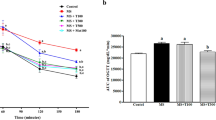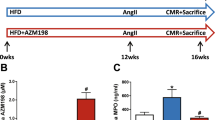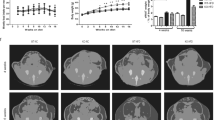Abstract
Aim:
Angiotensin-converting enzyme (ACE) inhibition can reduce the body weight of mice maintained on a high-fat diet. The current study examined the effect of the ACE inhibitor, captopril (CAP), on the reversal of diet-induced obesity (DIO), insulin resistance and inflammation in mice.
Materials and methods:
DIO was produced in C57BL/6J male mice (n=30) by maintaining animals on a high-fat diet (w/w 21% fat) for 12 weeks. During the subsequent 12-week treatment period, the animals were allowed access to the high-fat diet and either water containing CAP (0.05 mg ml−1) or plain tap water (CON, control).
Results:
From the first week of treatment, food intake and body weight decreased in CAP-treated mice compared with CON mice. Both peripheral insulin sensitivity and hepatic insulin sensitivity were improved in CAP-treated mice compared with CON mice. CAP-treated mice had decreased absolute and relative liver and epididymal fat weights compared with CON mice. CAP-treated mice had higher plasma adiponectin and lower plasma leptin levels than CON mice. Relative to CON mice, CAP-treated mice had reduced adipose and skeletal muscle monocyte chemoattractant protein 1 (MCP-1), adipose interleukin-6 (IL-6), toll-like receptor 4 (TLR4) and uncoupling protein 2 (UCP2) mRNA expressions. Furthermore, CAP-treated mice had increased peroxisome proliferator-activated receptor-γ coactivator-1α (PGC-1α), long chain acyl-CoA dehydrogenase (LCAD), hormone sensitive lipase (HSL) and decreased lipoprotein lipase (LPL) mRNA expressions in the liver.
Conclusion:
The results of the current study indicate that in mice with DIO, CAP treatment reduced food intake and body weight, improved insulin sensitivity and decreased the mRNA expression of markers of inflammation. Thus, CAP may be a viable treatment for obesity, insulin resistance and inflammation.
This is a preview of subscription content, access via your institution
Access options
Subscribe to this journal
Receive 12 print issues and online access
$259.00 per year
only $21.58 per issue
Buy this article
- Purchase on Springer Link
- Instant access to full article PDF
Prices may be subject to local taxes which are calculated during checkout





Similar content being viewed by others
Accession codes
References
Hilzendeger AM, Morais RL, Todiras M, Plehm R, Goncalves AD, Nakaie CR et al. Leptin regulates ACE activity in mice. J Mol Med 2010; 88: 899–907.
Schelbert KB . Comorbidities of obesity. Prim Care 2009; 36: 271–285.
Nguyen MT, Favelyukis S, Nguyen AK, Reichart DD, Scott PA . A subpopulation of macrophages infiltrates hypertrophic adipose tissue and is activated by free fatty acids via Toll-like receptors 2 and 4 and JNK-dependent pathways. J Biol Chem 2007; 282: 35279–35292.
Fried SK, Bunkin DA, Greenberg AS . Omental and subcutaneous adipose tissues of obese subjects release interleukin-6: depot difference and regulation by glucocorticoid. J Clin Endocrinol Metab 1998; 83: 847–850.
Samad F, Yamamoto K, Pandey M, Loskutoff DJ . Elevated expressions of transforming growth factor-β in adipose tissue from obese mice. Mol Med 1997; 3: 37–48.
Hotamisligil GS, Arner P, Caro JF, Atkinson RL, Spiegelman BM . Increased adipose tissue expression of tumor necrosis factor-α in human obesity and insulin resistance. J Clin Invest 1995; 95: 2409–2415.
Lumeng CN, Deyoung SM, Bodzin JL, Saltiel AR . Increased inflammatory properties of adipose tissue macrophages recruited during diet-induced obesity. Diabetes 2007; 56: 16–23.
Das UN . A perinatal strategy to prevent coronary heart disease. Nutrition 2002; 19: 1022–1027.
Saye JA, Ragsdale NV, Carey RM, Peach MJ . Localization of angiotensin peptide-forming enzymes of 3T3-F442A adipocytes. Am J Physiol 1993; 264: C1570–C1576.
Cooper R, Forrester T, Ogunbiyi O, Muffinda J . Angiotensinogen levels and obesity in four black populations. J Hypertens 1998; 16: 571–575.
Massièra F, Bloch-Faure M, Ceiler D, Murakami K, Fukamizu A, Gasc JM et al. Adipose angiotensinogen is involved in adipose tissue growth and blood pressure regulation. FASEB J 2001; 15: 2727–2729.
Jones BH, Standridge MK, Moustaid N . Angiotensin 11 increases lipogenesis in 3T3-L1 and human adipose cells. Endocrinology 1997; 138: 1512–1519.
Goossens GH, Blaak EES, Saris WH, van Baak MA . Angiotensin II-induced effects on adipose and skeletal muscle tissue blood flow and lipolysis in normal-weight and obese subjects. J Clin Endocrinol Metab 2004; 89: 2690–2696.
Chu KY, Leung PS . Angiotensin II in type 2 diabetes mellitus. Curr Protein Pept Sci 2009; 10: 75–84.
Brasier AR, Jamaluddin M, Han Y, Patterson C, Runge MS . Angiotensin II induces gene transcription through cell-type-dependent effects on the nuclear factor-kappaB (NF-kappaB) transcription factor. Mol Cell Biochem 2000; 212: 155–169.
Dai Q, Xu M, Yao M, Sun B . Angiotensin AT1 receptor antagonists exert anti-inflammatory effects in spontaneously hypertensive rats. Br J Pharmacol 2007; 152: 1042–1048.
Ji Y, Liu J, Wang Z, Liu N . Angiotensin II induces inflammatory response partly via toll-like receptor 4-dependent signaling pathway in vascular smooth muscle cells. Cell Physiol Biochem 2009; 23: 265–276.
Lv J, Jia R, Yang D, Zhu J, Ding G . Candesartan attenuates angiotensin II-induced mesangial cell apoptosis via TLR4/MyD88 pathway. Biochem Biophys Res Commun 2009; 380: 81–86.
Grassi G, Turri C, Dell'Oro R, Stella ML, Bolla GB, Mancia G . Effect of chronic angiotensin converting enzyme inhibition on sympathetic nerve traffic and baroreflex control of the circulation in essential hypertension. J Hypertens 1998; 16: 1789–1796.
Henriksen EJ, Jacob S, Kinnick TR, Teachey MK, Krekler M . Selective angiotensin II receptor antagonism reduces insulin resistance in obese Zucker rats. Hypertension 2001; 38: 884–890.
Higashiura K, Ura N, Takada T, Li Y, Torii T, Togashi N et al. The effects of an angiotensin-converting enzyme inhibitor and an angiotensin II receptor antagonist on insulin resistance in fructose-fed rats. Am J Hypertens 2000; 2000: 290–297.
Weisinger RS, Stanley TK, Begg DP, Weisinger HS, Spark KJ, Jois M . Angiotensin converting enzyme inhibition lowers body weight and improves glucose tolerance in C57BL/6J mice maintained on a high fat diet. Physiol Behav 2009; 98: 192–197.
Santos EL, de Picoli souza K, Guimarães PB, Reis FCG, Silva SMA, Costa-Neto CM et al. Effect of angiotensin converting enzyme inhibitor enalapril on body weight and composition in young rats. Int Immunopharmacol 2008; 8: 247–253.
de Kloet AD, Krause EG, Kim DH, Sakai RR, Seeley RJ, Woods SC . The effect of angiotensin-converting enzyme inhibition using captopril on energy balance and glucose homeostasis. Endocrinology 2009; 150: 4114–4123.
Albuquerque D, Nihei J, Cadillo F, Singh R . The ACE inhibitors enalapril and captopril modulate cytokine responses in Balb/c and C57Bl/6 normal mice and increase CD4(+)CD25(negative) splenic T-cell numbers. Cell Immunol 2010; 260: 92–97.
Hansson L, Lindholm LH, Niskanen L, Lanke J, Hedner T, Niklason A et al. Effect of angiotensin-converting-enzyme inhibition compared with conventional therapy on cardiovascular morbidity and mortality in hypertension: the Captopril Prevention Project (CAPPP) randomised trial. Lancet 1999; 353: 611–616.
Beevers DG, Weissberg PL, Thurston H, Bing RF, Breckenridge A, L'Orme M et al. Enalapril in essential hypertension: a comparative study with propranolol. Enalapril in hypertension study group (UK). Br J Pharmacol 1984; 18: 51–56.
Lafontan M, Langin D . Lipolysis and lipid mobilization in human adipose tissue. Prog Lipid Res 2009; 48: 275–297.
Puigserver P, Spiegelman BM . Peroxisome proliferator-activated receptor-gamma coactivator 1 alpha (PGC-1 alpha): transcriptional coactivator and metabolic regulator. Endocr Rev 2003; 24: 78–90.
Lazarow PB . Rat liver peroxisomes catalyze the β oxidation of fatty acids. J Biol Chem 1978; 253: 1522–1528.
Jayasooriya AP, Mathai ML, Walker LL, Begg DP, Denton DA, Cameron-Smith D et al. Mice lacking angiotensin-converting enzyme have increased energy expenditure, with reduced fat mass and improved glucose clearance. Proc Natl Acad Sci USA 2008; 105: 6531–6536.
Maffei M, Halaas JL, Ravussin E, Pratley RE, Lee GH, Zhang Y et al. Leptin levels in human and rodent: measurement of plasma leptin and ob RNA in obese and weight-reduced subjects. Nat Med 1995; 1: 1155–1161.
Masaki T, Chiba S, Yasuda T, Tsubone T, Kakuma T, Shimomura I . Peripheral, but not central, administration of adiponectin reduces visceral adiposity and up regulates the expression of uncoupling protein in agouti yellow (Ay/a) obese mice. Diabetes 2003; 52: 2266–2273.
Qi Y, Takahashi N, Hileman SM, Patel HR, Berg AH, Pajvani UB . Adiponectin acts in the brain to decrease body weight. Nat Med 2004; 10: 524–529.
Yamauchi T, Kamon J, Minokoshi Y, Ito Y, Waki H, Uchida S . Adiponectin stimulates glucose utilization and fatty-acid oxidation by activating AMP-activated protein kinase. Nat Med 2002; 8: 1288–1295.
Lihn AS, stergård T, Nyholm B, Pedersen SB, Richelsen B, Schmitz O . Adiponectin expression in adipose tissue is reduced in first-degree relatives of type 2 diabetic patients. Am J Physiol Endocrinol Metab 2003; 284: 443–448.
Kurata A, Nishizawa H, Kihara S, Maeda N, Sonoda M, Okada T et al. Blockade of the angiotensin II type-1 receptor reduces oxidative stress in adipose tissue and ameliorates adipocytokine dysregulation. Kidney Int 2006; 70: 1717–1724.
Hattori Y, Akimoto K, Gross S, Hattori S, Kasai K . Angiotensin-II-induced oxidative stress elicits hypoadiponectinaemia in rats. Diabetologia 2005; 48: 1066–1074.
Suzuki H, Eguchi S . Adiponectin versus angiotensin II: key pathological role of their misbalance. Kidney Int 2006; 70: 1678–1679.
Kintscher U, Unger T . Vascular protection in diabetes: a pharmacological view of angiotensin II type 1 receptor blockers. Acta Diabetol 2005; 42: S26–S32.
Jayasooriya AP, Begg DP, Chen N, Mathai ML, Sinclair AJ, Wilkinson-Berka J et al. Omega-3 polyunsaturated fatty acid supplementation reduces hypertension in TGR(mRen-2)27 rats. Prostagland Leukot Essent Fatty Acids 2008; 78: 67–72.
Weisinger HS, Begg DP, Egan GF, Jayasooriya AP, Lie F, Mathai ML et al. Angiotensin converting enzyme inhibition from birth reduces body weight and body fat in Sprague–Dawley rats. Physiol Behav 2008; 93: 820–825.
Mathai ML, Naik S, Sinclair AJ, Weisinger HS, Weisinger RS . Selective reduction in body fat mass and plasma leptin induced by angiotensin-converting enzyme inhibition in rats. Int J Obes 2008; 32: 1576–1584.
Campbell DJ, Kladis A, Duncan AM . Effects of converting enzyme inhibitors on angiotensin and bradykinin peptides. Hypertension 1994; 23: 439–449.
Weisinger RS, Denton DA, Di Nicolantonio R, McKinley MJ, Muller AF, Tarjan E . Role of angiotensin in sodium appetite of sodium-deplete sheep. Am J Physiol 1987; 253: R482–R488.
Mietlicki EG, Nowak EL, Daniels D . The effect of ghrelin on water intake during dipsogenic conditions. Physiol Behav 2009; 96: 37–43.
Pederson BA, Schroeder JM, Parker GE, Smith MW, DePaoli-Roach AA, Roach PJ . Glucose metabolism in mice lacking muscle glycogen synthase. Diabetes 2005; 54: 3466–3473.
Hu E, Liang P, Spiegelman BM . AdipoQ is a novel adipose-specific gene dysregulated in obesity. J Biol Chem 1996; 271: 10697–10703.
De Fronzo RA . Pathogenesis of type 2 diabetes: metabolic and molecular implications for identifying diabetes genes. Diabetes Rev 1997; 5: 177–269.
Biddinger SB, Kahn CR . From mice to men: insights into the insulin resistance syndromes. Annu Rev Physiol 2006; 68: 123–158.
Zimmet P, Alberti KG, Shaw J . Global and societal implications of the diabetes epidemic. Nature 2001; 414: 782–787.
Xinghai L, Bobby M, Qingyuan G, Morris JB . Akt/PKB regulates hepatic metabolism by directly inhibiting PGC-1α transcription coactivator. Nature 2007; 47: 1038–1042.
Senn JJ, Klover PJ, Nowak IA, Zimmers TG, Koniaris LG, Furlanetto RW et al. Suppressor of cytokine signaling-3 (SCOCS-3), a potential mediator of interleukin-6-dependent insulin resistance in hepatocytes. J Biol Chem 2003; 278: 13740–13746.
Sabio G, Das M, Mora A, Zhang Z, Jun JY, Ko HJ et al. A stress signaling pathway in adipose tissue regulates hepatic insulin resistance. Science 2008; 322: 1539–1543.
Zhang CY, Baffy G, Perret P . Uncoupling protein-2 negatively regulates insulin secretion and is a major link between obesity, beta cell dysfunction, and type 2 diabetes. Cell 2001; 105: 745–755.
Das UN . Is obesity an inflammatory condition? Nutrition 2001; 17: 953–966.
Bruun JM, Lihn AS, Pedersen SB, Richelsen B . Monocyte chemoattractant protein-1 release is higher in visceral than subcutaneous human adipose tissue: implication of macrophages resident in the adipose tissue. J Clin Endocrinol Metab 2005; 90: 2282–2289.
Kanda H, Tateya S, Tamori Y, Kotani K, Hiasa K, Kitazawa R et al. MCP-1 contributes to macrophage infiltration into adipose tissue, insulin resistance, and hepatic steatosis in obesity. J Clin Invest 2006; 116: 1494–1505.
Acknowledgements
This work was supported by the National Health and Medical Research Council of Australia (Project Grants 350313 and 433021, Training Fellowship 1013264) and the Australian Research Council (Grant number LP0883996).
Author contributions
MJ, DC-S and RSW designed the research; SDP, DJR and AH performed the research; EM, DC-S and RSW contributed new reagents/analytical tools; SDP, DPB and RSW analysed the data; SDP, DPB and RSW interpreted the data and drafted the manuscript. EM, DPB, MJ, DC-S and RSW critically reviewed the paper. All authors read and approved the final manuscript.
Author information
Authors and Affiliations
Corresponding author
Ethics declarations
Competing interests
The authors declare no conflict of interest.
Rights and permissions
About this article
Cite this article
Premaratna, S., Manickam, E., Begg, D. et al. Angiotensin-converting enzyme inhibition reverses diet-induced obesity, insulin resistance and inflammation in C57BL/6J mice. Int J Obes 36, 233–243 (2012). https://doi.org/10.1038/ijo.2011.95
Received:
Revised:
Accepted:
Published:
Issue Date:
DOI: https://doi.org/10.1038/ijo.2011.95
Keywords
This article is cited by
-
Autophagy in metabolic syndrome: breaking the wheel by targeting the renin–angiotensin system
Cell Death & Disease (2020)
-
Angiotensin II Increases Endoplasmic Reticulum Stress in Adipose Tissue and Adipocytes
Scientific Reports (2019)
-
Nonerythropoietic Erythropoietin-Derived Peptide Suppresses Adipogenesis, Inflammation, Obesity and Insulin Resistance
Scientific Reports (2015)
-
Effect of Angiotensin-Converting Enzyme Inhibitors on Physical Function in Elderly Subjects: A Systematic Review and Meta-Analysis
Drugs & Aging (2015)
-
The endocrinology of food intake
Nature Reviews Endocrinology (2013)



